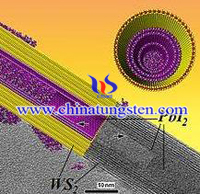Tungsten Disulfide Nanotubes Preparation

Tungsten disulfide nanotubes belongs inorganic nanotubes, which is discovered by Israeli scientists Reshef Tenne in 1992, and declared the birth of inorganic nanotubes. Inorganic nanotubes is usually composed of cylinder molecular structure metal oxide, with the shape similar to carbon nanotubes, but heavier, and not strong enough under tension; however, inorganic nanotubes have extremely strong resistance to pressure, and therefore have the potential of making to be anti-collision product, such as body armor.
A lot of research work have carried out for the preparation of tungsten disulfide nanotubes (WS2), the main methods currently are high-temperature gas-solid reaction, thermal decomposition and hydrothermal method ect.. Initially, Tenne and his team synthesized tungsten disulfide nanotubes by the reduction of tungsten oxide in the atmosphere of hydrogen or hydrogen sulfide under 850°C; C.N.R.Rao ect. prepared tungsten disulfide nanotubes by direct thermal decomposition of ammonium tungstate in the hydrogen under high temperature of 1200°C~1300°C; Chen et al. by at H2 and vinyl acetylene (C4H4) and S vapor atmosphere of thermal decomposition of ammonium thiosulfate under 400°C to prepare tungsten disulfide nanotubes.
An invention has pointed out that (NH4)2WS4 as raw materials for preparing tungsten disulfide nanotubes, which the process includes preparing template , dipping, pyrolysis and separation. The process reflected: immersed the AAO template in DMSO solution of NH4)2WS4 with concentration of 0.2~0.4mol/L for no less than half an hour; after takes out the template and volatilizes the solvent of DMSO, the sample was placed in reducing atmosphere for 1~2h calcination at 500~600℃, cooled and separated from the AAO template to get WS2 nanotubes.
If you have any interest in tungsten disulfide, please feel free to contact us by email: sales@chinatungsten.com or by telephone:+86 592 5129696.
More info>>
